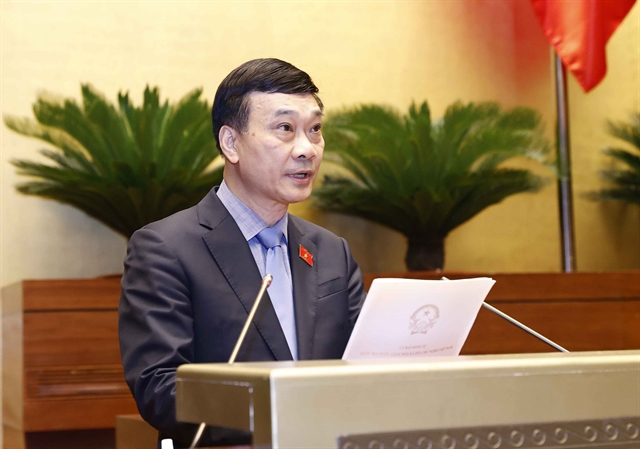
HÀ NỘI — The National Assembly’s Economic Committee agreed with the Government’s proposal to invest in building three expressways along Châu Đốc-Cần Thơ-Sóc Trăng; Khánh Hòa-Buôn Ma Thuột; and Biên Hòa-Vũng Tàu.
Vũ Hồng Thanh, chairman of the National Assembly's Economic Committee, said the construction aims to concretise the 10-year socio-economic development strategy for 2021-30, which was approved by the 13th Party Congress.
Thanh made the statement on Monday morning at the third session of the 15-tenure National Assembly.
At the same time, the investment in the expressways will promote the socio-economic development of the localities which the expressways run through, helping to enhance the assurance of national defence and security, he said.
However, it is necessary to carefully evaluate the urgency, the ability to allocate resources and the impact of using public investment capital to deploy many infrastructure projects at the same time on inflation, disbursement capacity, capital absorption and efficiency, as well as the ability to cause scarcity and increase in raw building material prices, he said.
Thanh also said that it is appropriate when the Government proposed to apply the public investment model instead of the public-private partnership model to the projects building expressways of Khánh Hòa-Buôn Ma Thuột and Châu Đốc-Cần Thơ-Sóc Trăng, because these two routes have low vehicle traffic and long payback periods.
The committee also agreed with the proposal of the Government to apply the model of public-private partnership to the project of building the Biên Hòa-Vũng Tàu Expressway, he said.
It is imperative to attract the private sector to participate in the investment in building the expressway while the State investment is used to deploy many major transport infrastructure projects at the same time, he said.
Besides, the committee concurred with the proposal to build Ring Road 4 in Hà Nội and Ring Road 3 in HCM City, he said.
The committee required a full assessment of the ability to disburse and absorb capital, and balance efficiency in resource allocation, management capacity, and human resources, as well as the ability to cause scarcity and increase in raw building material prices, he said.
Based on the assessment, timely solutions will be made to ensure the feasibility, efficiency, progress and quality of the two projects, he added.
Government’s proposal
Minister of Transport Nguyễn Văn Thể presented the proposal of the Government to build the expressways on Monday morning.
Thể said the investment to build the expressways aims to meet the increasing transportation demand, solve traffic infrastructure bottlenecks in the southern key economic region, and exploit the advantages of the Central Highlands and the Mekong River Delta.
It also helps in improving the national competitiveness of the Central Highlands, south-central coast, south-east region and Mekong River Delta, creating a premise, motivation and new space for socio-economic development, contributing to national defence and security, he said.
Thể said the Biên Hòa-Vũng Tàu Expressway is 53.7 km long, running through two provinces, connecting Biên Hòa City with Cái Mép-Thị Vải seaport. It is set to have four to six lanes in the first phase of the project.
The Khánh Hòa-Buôn Ma Thuột Expressway is 117.5 km long, running through two provinces, connecting Buôn Ma Thuột City with Nam Vân Phong seaport. It is set to have four lanes in the first phase of the project.
The Châu Đốc-Cần Thơ-Sóc Trăng Expressway is 188.2 km long, running through four localities, connecting Châu Đốc City with Trần Đề seaport. It is set to have four lanes in the first phase of the project.
For the two projects of building Khánh Hòa-Buôn Ma Thuột Expressway and Châu Đốc-Cần Thơ-Sóc Trăng Expressway, the Government proposes to invest in the public investment model, he said.
After being put into operation, fees will be collected to return the State budget capital, he said.
Thể said the capital demand to implement the three projects in the period of 2021-25 will be about VNĐ60.1 trillion (US$2.58 billion) and about VNĐ24.3 trillion ($1.04 billion) from 2026 to 2030.
Also at the session, Minister of Planning and Investment Nguyễn Chí Dũng, who presented the pre-feasibility study report to build Ring Road 4 in Hà Nội and Ring Road 3 in HCM City, said the two projects play the role of linking the region, promoting the development of urbanisation and having great significance for socio-economic development.
The investment and completion of the two projects will contribute to improving the competitiveness of the economy, increasing traffic connectivity between provinces in the regions, stretching the population density in urban areas and reducing pressure on inner-city traffic and existing roads, he said.
Ring Road 4 in Hà Nội has a length of 112.8 km, running through Hà Nội (58.2km); Hưng Yên Province (19.3km) and Bắc Ninh Province (25.6km).
Ring Road 3 in HCM City is 76.34 km long, running through HCM City (47.51 km); Đồng Nai Province (11.26km); Bình Dương (10.76km) and Long An (6.81km).
The preliminary total investment in the first phase of the project to build the Ring Road 4 is estimated to be about VNĐ85.8 trillion ($3.67 billion), using the State budget’s capital and Built-Operate-Transfer (BOT) investors' capital, of which BOT capital is VNĐ29.4 trillion ($1.25 billion).
The preliminary total investment in the first phase of the Ring Road 3 project is about VNĐ75.3 trillion ($3.22 billion) from the State budget.— VNS